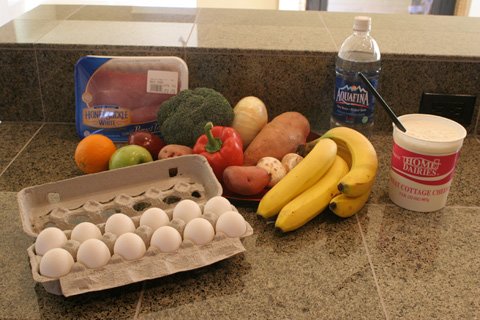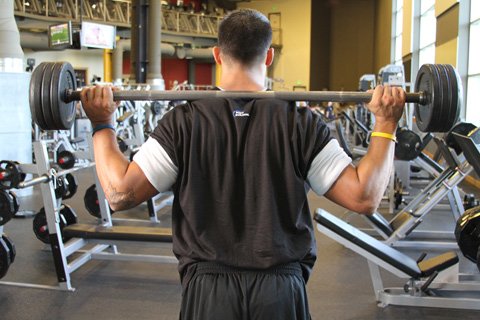MR.OLYMPIA & MR. ASIA SULTAN AHMAD
Tuesday, 12 July 2011
Monday, 11 July 2011
3 Things You Must Know About Muscle Building!
Today I wanted to try and explain exactly what it takes to build muscle without going into too complicated of details. I find that there are so many people and authors out there today that over complicate this topic to simply lure you into buying their latest program or their newest supplement.
Now of course, I have my own muscle building program and I would recommend some supplements to you as well but I am not saying that it is wrong. Today I simply want to give you good information that will hopefully clear up any confusion about what it takes to build muscle in its essence.
I am going to keep this nice and simple and base it on personal experience because in the end I believe your own personal experiences are the best way to measure any kind of results. You cannot simply rely on 'studies' or 'university tests' as most of these tests are either biased or they are based on genetically gifted individuals.

I Am Going To Keep This Nice And Simple And Base It On Personal Experience Because In The End I Believe Your Own Personal Experiences Are The Best Way To Measure Any Kind Of Results.
What Do You Need To Do To Build Muscle?
Well let's think about this question for a moment.
First, understand that your body is more than content with staying exactly the way it is right now. It would rather not change and it is programmed to be this way after thousands of years of evolution. This means that to make any change in our body's composition, we are going to have to 'coax' it or persuade it in doing so.
So for today's purpose, building muscle, how do we persuade our bodies to do this?
Well we have to give it a 'reason' to grow!
There are many ways to do this but I am going to break it down into some manageable chunks:
1. Caloric Surplus
One of the keys to gaining muscle and weight is to consume more calories. The reason we want to give our bodies more calories is because if we are going to demand more out of them than what they are accustomed to, then we need to feed them with more fuel. Think of it as if you want to travel further in a car. If one tank of gas gets you so far but you want to go further, you need to have more gas right? It's the same for building muscle. Feed it more so you have more energy to push it into spurting new muscle. Now without going into excruciating details (which is not the point of this particular article), you cannot simply overfeed on junk food. Make sure you are eating lean proteins, complex carbohydrates and healthy fats.
2. Progressive Overloa
Now that you are eating enough to give your body 'extra energy' you will need to stress the muscles so that they respond by getting bigger.
Your muscles are currently the size they are based on the level of activity you have done in the past, your genetics and your strength. We cannot change your genetics, but we can however change your strength to a degree as well as elicit hypertrophy (muscle building) by weight training.
To put it simply, you need to start progressively overloading your body with some form of resistance training. Honestly, do not get too concerned about finding that 'special' program that will be better than all the other programs out there. There are just too many training programs to try and choose 'the best' one.
In my experience, they all work! Yes of course some may be better than others but in the end you will get results no matter which program you try as long as you follow the key rules to muscle building. Rely on the foundation and principles instead of the program. In doing so, you will get results no matter which program you are on.
What Are The Foundation And Principles?
- Progressive Overload
- Adapt
- Proper Form
- Mindset
- Rest and Recovery
Pretty simple right?The main thing is to continue stressing the muscles by either overloading with volume training, getting stronger by strength training and making sure to give your body enough time to rest and recover and therefore grow!This is not to say that you can just keep getting stronger to the point that you will be performing 1000lb bench presses, but by cycling your training through different stages, you will start to get closer to what your genetic potential for muscle mass really is. Eventually the gains will get harder to come by, but if you are just starting out, this will not be an issue.
3. Accepting The Inevitable
By applying the right factors for muscle building, you will start to gain lean mass and you will start to gain weight which is good because that is the goal we are after.
However, you need to also accept that when you are gaining muscle that it is almost impossible not to gain a bit of fat while doing so. Now I know there are going to be a lot of people claiming that it can be done but in my experience these are people who are genetically gifted and they are the exception to the rule.
Other people who tell you this may be people trying to sell you something.
Finally, you can gain eliminate fat gain by gaining muscle at a slower rate.
It is your choice, but for those of you who want to build some serious muscle as quickly and effectively as possible, then you will just have to accept a bit of fat gain.
20 Ways To A Healthier You!
1. Hit The Hay
4. Stay Positive
5. Get Weak
12. Buy A Piece Of Exercise Equipment
15. Take A Walk
18. Be Pro Protein
19. Run For Your Life

- Somebody said sleep was for the weak - and that's the weakest thing we've ever heard. From contributing to better alertness on the job, to giving your body the kind of rejuvenation it needs to get the most out of your workouts, hit the pillow or you'll hit a wall in your accomplishments.
- Write down how much weight, how many reps and sets you do for your workouts. It will help you to shoot for new highs the next time and also will inform you instantly on whether your strength gains are where they need to be.
- We all need to unwind and a cold brew or Courvoisier goes down smooth, but a few too many and you lose tomorrow's productivity to Old Man Hangover. If you want to be at your best, drink a lil' less.
4. Stay Positive
- It's been proven a thousand times that positive thinking is one of your best allies. From aiding athletes in turning assumed losses into victory (Namath!), to helping patients stay healthy, by expecting good things to happen, you increase your chances of getting what you want.
5. Get Weak
- Anybody can work on their strengths, but it's improving your weaknesses that will make you succeed a lot easier in the gym. Find that certain underdeveloped muscle group and work on it at the beginning of your workout, because that's when your energy is at its peak.
- Even the most seasoned athlete can get lazy with stretching, but it only takes hearing one "pop" to learn your lesson - and be put through complex and grueling rehab. Make sure to hit all the important muscles, especially those forgotten hamstrings.
Vide
7. Grab A Partner - Though it can be hard to coordinate schedules, finding a training partner can add an instant motivator to your gym time, along with someone to make sure you maintain correct form. Nothing can get you in the gym on a cold day like a partner saying those three words of encouragement: "You Freaking Woosie!"
- We all love seeing those golden arches, but those lumpy love handles, not so much. Eliminate your fast food by half and you'll see your body respond. If you need help, go rent Morgan Spurlock's " Supersize Me." It ain't pretty.
- Try to put aside five minutes a day to meditate. It's proven that deep breathing and mental relaxation can keep the body at its best. Ohmmmmm... Ohmmmmm...
- Humans are made up of more than 90% water, so why do we drink so little of it? If you're passing on el agua then you're passing up on one of the best sources for health and energy on Earth. And, no, Cokes don't count.
- The lower back is one of the last areas people tend to work, yet one of the most vital areas to keep up to avoid injury. Whether deadlifts or hyperextensions, do some sort of strengthening movement or we see a chiropractor in your future. Also, a stronger lower back leads to better abs because they're opposing muscle groups.
12. Buy A Piece Of Exercise Equipment
- Even if it's just a stationary bike, one of the best purchases you can make is a piece of home exercise equipment. This way, bad weather won't be an excuse not to get your sweat on (though laziness is a pretty good excuse, too).
- With very few exceptions, no matter where you eat, you never know for sure how many calories or fat are on the menu. At home, you can regulate everything that enters your body, not to mention, save a few bucks in your pocket.
- Working hard is great. Working your life away is... well, unhealthy. Make time to just relax, whether that's getting together with friends, watching a sporting event or just reading a new book. Seriously, you're stressing us out, dude!
15. Take A Walk
- Are you one of those people who drives to a store just down the block? Try keeping that car in park and strap on your sneakers, Mr. Lead foot. An extra 30 minutes of walking a day has numerous health benefits and on days when you don't get to the gym, it's better to have some cardio than none.
- While the body needs fat to survive, most of us could survive many times over from the amount of fat we take in. Make sure to read the labels on your food for how much saturated fat you're ingesting and don't let it go above the daily allowances. Unless double chins are in this year.
- Participating in sports is not only a good social activity, but it burns calories and improves coordination. Just because you're not a kid anymore, doesn't mean the blacktop and diamond should be off limits. Be a participant in life!
18. Be Pro Protein
- Nothing builds muscle like protein. If you can get a gram of protein per every pound, more power to you, but just half a gram can do a world of good... of course, that's only if you put the time in the gym to back it up.
19. Run For Your Life
- Running is still one of the top ways to measure your level of fitness. But it requires the right footwear, correct stride and the patience to allow your running times to improve gradually. By adding your favorite music or favorite friend to run with, the time will fly by - and your gut will likely shrink.
- They say it's much harder to stay angry than forgive. Let go of those grudges that have been weighing you down, because that squat bar weighs enough already.

10 Tips For Long Term Weight Loss.
Subscribe to:
Comments (Atom)

























